
Guests
- President Obamaaddressing a vigil for the Newtown massacre victims Sunday night.
- Paul Barrettassistant managing editor at Bloomberg Businessweek. His latest book is Glock: The Rise of America’s Gun.
In the deadliest rampage at an elementary school in U.S. history, 20 first-grade students and six staff members were killed Friday in Newtown, Connecticut. All of the children killed were six and seven years old. They were all shot multiple times. At a vigil for the victims Sunday night, President Obama vowed unspecified action to curb gun violence in the United States. “We can’t tolerate this anymore,” Obama said. “These tragedies must end. And to end them, we must change. … Are we really prepared to say that we’re powerless in the face of such carnage, that the politics are too hard? Are we prepared to say that such violence visited on our children year after year after year is somehow the price of our freedom?” We’re joined by Paul Barrett, assistant managing editor at Bloomberg Businessweek and author of “Glock: The Rise of America’s Gun.” [includes rush transcript]
Transcript
AMY GOODMAN: Funeral services are being held today in Connecticut for two of the victims in Friday’s shooting massacre at the Sandy Hook Elementary School in Newtown, Connecticut. Noah Pozner and Jack Pinto were both six years old. They died on Friday along with 18 of their classmates and six staff members at the school. All of the children killed were six and seven years old. They were all shot multiple times. It was the deadliest rampage at an elementary school in U.S. history. Police said the gunman, 20-year-old Adam Lanza, used a semi-automatic Bushmaster assault rifle, similar to the M4 carbine used by the U.S. military. He also had two handguns, a Glock 9-millimeter semi-automatic pistol, and a SIG Sauer.
On Sunday, President Obama spoke at an interfaith vigil in Newtown.
PRESIDENT BARACK OBAMA: We can’t tolerate this anymore. These tragedies must end. And to end them, we must change. We will be told that the causes of such violence are complex, and that is true. No single law, no set of laws can eliminate evil from the world or prevent every senseless act of violence in our society. But that can’t be an excuse for inaction. Surely, we can do better than this. If there is even one step we can take to save another child or another parent or another town from the grief that’s visited Tucson and Aurora and Oak Creek and Newtown and communities from Columbine to Blacksburg, before that, then surely we have an obligation to try.
In the coming weeks, I will use whatever power this office holds to engage my fellow citizens—from law enforcement to mental health professionals, to parents and educators—in an effort aimed at preventing more tragedies like this. Because what choice do we have? We can’t accept events like this as routine. Are we really prepared to say that we’re powerless in the face of such carnage, that the politics are too hard? Are we prepared to say that such violence visited on our children year after year after year is somehow the price of our freedom?
AMY GOODMAN: Friday’s massacre occurred in Newtown, Connecticut, home of the National Shooting Sports Foundation, a group described as the second-most-powerful pro-gun lobby in the country after the National Rifle Association.
On Sunday, Democratic Senator Dianne Feinstein of California vowed to introduce a new assault weapons ban on the first day of the new Congress, challenging President Obama to back the bill. Connecticut Governor Dannel Malloy told CNN the federal ban should not have been allowed to expire.
GOV. DANNEL MALLOY: I think when we talk about the assault weapons ban that was in place in the United States, to have allowed that to have gone away—these are assault weapons. You don’t—you don’t hunt deer with these things. One can only hope that we’ll find a way to limit these weapons that really only have one purpose.
AMY GOODMAN: In a moment, we’ll host a debate between the Gun Owners of America and the Coalition to Stop Gun Violence. But first we’re joined by Paul Barrett, assistant managing editor of Bloomberg Businessweek. His latest book is called Glock: The Rise of America’s Gun.
Paul, welcome back to Democracy Now!
PAUL BARRETT: Thanks.
AMY GOODMAN: Talk about what happened on Friday and put it in the context of gun violence in this country.
PAUL BARRETT: Well, what we saw is yet another one of these hugely disturbing mass killings that I think is the almost inevitable outcome of a society that’s permeated by firearms—some 300 million guns in private hands right now—the intersection of a society like that with mental illness, which is almost inevitable in society. And once again, we have a young man who, for reasons we don’t yet know and may never know, snapped, and guns were readily at hand. So, that would be my first cut at what—the awful thing that happened in Connecticut.
AMY GOODMAN: Oddly, just 12 hours—something like that—before, in China, another mentally disturbed man went into a school and knifed 23 people, 22 of them children. Ultimately, I think, at this point, one has died. The difference was, he had a knife; Adam Lanza had a gun.
PAUL BARRETT: Right. Well, the United States, for better or for worse, is a gun culture. We are a culture that, uniquely in the world, sees value and significance in firearms. This has been the case since the founding of the republic. The Second Amendment is scorned by many people, but it’s been there since the beginning, enacted in 1791, and it’s very, very meaningful to millions and millions of people in this country. And firearms represent not something evil to many Americans, but something associated with individuals and self-reliance, the American profile. And as a result, we end up with a country that is, as I said, suffused with firearms.
AMY GOODMAN: On Meet the Press on Sunday, the author of the 1994 Assault Weapons Ban, Senator Dianne Feinstein, announced she is introducing a bill to reform gun ownership standards in the next Congress.
SEN. DIANNE FEINSTEIN: I’m going to introduce in the Senate, and the same bill will be introduced in the House, a bill to ban assault weapons. It will ban the sale, the transfer, the importation and the possession, not retroactively, but prospectively. And it will ban the same for big clips, drums or strips of more than 10 bullets. So there will be a bill. We’ve been working on it now for a year. We’ve tried to take my bill from ’94 to 2004 and perfect it. We believe we have. We exempt over 900 specific weapons that will not be—fall under the bill.
AMY GOODMAN: Nine hundred specific weapons will not fall under the bill, the last words of Senator Dianne Feinstein as she talks about introducing an assault weapons ban on the first day the Senate returns.
PAUL BARRETT: Yeah. Well, I’ll read the legislation very closely when it’s actually out. I have to say I’m skeptical. I mean, the 1994 so-called Assault Weapons Ban was one of the most porous, ineffective pieces of legislation that I personally have ever had the opportunity to study. It was shot through with loopholes. It had no applicability to weapons that were made and sold on the day before enactment. And the fact that it was coming for a period of years gave gun manufacturers an opportunity to run their factories overtime and to build up huge stockpiles of the weapons. So we’ll see. But if Congress is not proposing to ban weapons that are already out there, then that leaves millions and millions of weapons already out there.
AMY GOODMAN: How many are we looking at at this point? It’s believed 300 million?
PAUL BARRETT: Yeah, that includes the whole universe. You’re talking about handguns, shotguns, grandpa’s deer-hunting rifle and these military-style assault weapons. But there have been millions of these military-style assault weapons sold in just the last few years. So they’re not going away, unless someone is proposing a confiscation law, which so far I haven’t heard anybody propose. Now, there are states, including Connecticut, by the way, that have stricter state-level laws for certain kinds of guns, and that’s up to a state to do if it wants to. But we have to be very vigilant in separating symbolism from effective legislation. And in the past, a lot of gun control laws have been more symbolism.
AMY GOODMAN: Paul, you were the first in the media on Friday to point out that this elementary school in Newtown is not far from the headquarters of the National Shooting Sports Foundation in Newtown. Explain what that is.
PAUL BARRETT: The National Shooting Sports Foundation is basically the trade association for the manufacturers and marketers of guns and ammunition. It is effectively a sister organization to the better-known NRA, which represents the interests of gun owners. So the NRA advocates on behalf of the customers, and the NSSF advocates on behalf of the manufacturers. Of course, their interests intersect on many, many issues, and they operate hand in hand on many issues.
And what was striking to me was that the NSSF is based in this very placid exurb of New York, the same way the NRA is based in the bucolic confines of Fairfax, Virginia. And I don’t think that there’s anything particularly remarkable about the geographic proximity between the shooting tragedy and the NSSF beyond the fact that it shows us that guns really are normal and a routine part of American life. I mean, the NSSF is not holed up in some castle someplace behind barbed wire and machine guns; it’s in a building that you might think is a medical professional building up on a hill. It looks very innocuous. Guns are not exceptional in the United States; they are the norm.
AMY GOODMAN: And put them in the context globally. Compare Canada, Germany, Australia. Where do we stand when it comes to gun deaths in America?
PAUL BARRETT: Our gun homicide rate is greater by orders of magnitude compared to all other comparable societies, which is to say industrialized democracies. Our overall violent crime rate—and this is a distinction worth making—is not as distinct. In other words, you’re not necessarily in greater peril of having your car stolen or having someone hit you over the head with a baseball bat in the United States. In fact, New York City is safer than many other big cities around the world in terms of violent crime overall. What we have in this country is a gun homicide problem. Our crime is more lethal because we have more—we have more guns.
AMY GOODMAN: We’re talking about something like 9,000 homicide gun deaths in the United States every year.
PAUL BARRETT: Right.
AMY GOODMAN: I think Canada has something like 150, 160; Germany, 170. I mean, we’re talking magnitude larger. And then you would include suicide, and what is it, in the United States using guns?
PAUL BARRETT: Well we have—we have roughly something on order of 30,000 gun deaths a year, but the large majority of those gun deaths are suicides.
AMY GOODMAN: We’re talking to Paul Barrett. When we come back, he’ll stay with us, but we’ll also host a debate on the issue of gun violence in America. Paul Barrett is assistant managing editor at Bloomberg Businessweek. His latest book is called Glock: The Rise of America’s Gun. Stay with us.

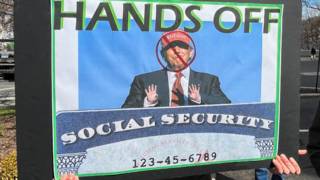
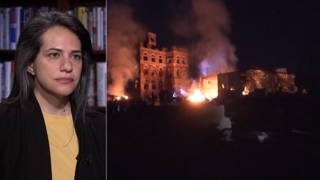





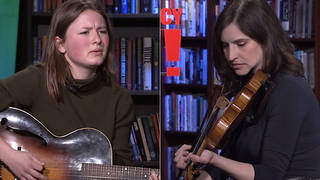

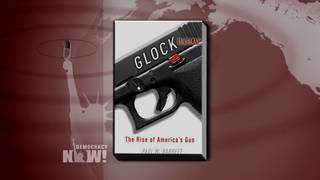
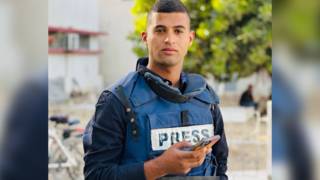
Media Options